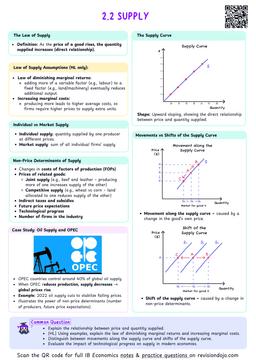Demand
Various quantities of a good or service that consumers are willing and able to buy at different possible prices during a particular time period, ceteris paribus.
The ceteris paribus assumption
Ceteris paribus is a latin expression that means "other things being equal". In an economics context, ceteris paribus indicates that all other variables other than those that are being analysed are unchanged or constant.
Assumptions underlying the Law of Demand(HL only)
The Law of Demand
The law of demand states that, as the price of a good increases, the quantity demanded decreases, ceteris paribus.
- The law of demand essentially suggest that there is a negative relationship between price and quantity demanded (as one increases, the other decreases).
- In order to understand this negative relationship, we need to analyse its underlying assumptions:
- The Law of Diminishing Marginal Utility.
- Income and substitution effects.
The Law of Diminishing Marginal Utility
Marginal utility
The satisfaction obtained from consuming one more unit of a good or service.
Law of Diminishing Marginal Utility
As more of a good is consumed, the additional satisfaction (marginal utility) gained from each extra unit decreases, and so consumers will only buy more of the good if its price falls.
Utility
Utility is the satisfaction that a consumer receives by consuming a good/service.
The Law of Diminishing Marginal Utility, indicates that:
- The marginal utility of a consumer from consuming one extra unit decreases as the quantity consumed increases (negative relationship).
- Therefore, as consumers increase their quantity consumed, they are only willing to buy more if the price of the good falls.
- This Law of Diminishing Marginal Utility is responsible for the Law of Demand (negative relationship between the price of a good and the quantity consumed).
- For example, suppose a person who likes burgers.
- Now imagine that this person eats one burger which he really likes. From this burger he gets a high utility, as he hasn't eaten burger in a while, and he was craving it
- Now imagine, that he buys another burger. He is still very happy that he gets to eat another burger, but he is maybe not as happy with this second burger as he was with the first one, because he is not so hungry anymore.
- After eating this second burger, our guy decides to buy one more burger. This third burger does not give provide him any marginal utility, because right now he is full and if he eats one more he will start to feel sick.
- Therefore, if your guys was willing to pay $10 for his first burger:
- He may only be willing to pay $8 for his next one (since he is not getting the same utility).
- He may be willing to pay only 6$ for his third burger (since this one provides him with even less utility).
- This example demonstrates the concept of diminishing marginal returns, as the extra satisfaction by the person who liked burgers decreased as he ate more burgers, which makes him want to pay less the more the quantity consumed increases.
- This negative relationship between the price of a good and the amount of it that is consumed is reflected in the Law of Demand.
Note that the term marginal means additional. For example:
- Marginal utility = additional utility for each extra unit produced.
- Marginal cost = additional cost for each extra unit produced.
Income and substitution effects
The income effect and the substitution effect are other assumptions that describe the negative relationship between price and quantity demanded:
Income effects
The income effect arises when:
- The price of a good changes.
- But the income of the consumers who buy this good does not change.
If the price of a good increases, whereas the consumer's income remains constant:
- The consumer now can buy less of that good.


